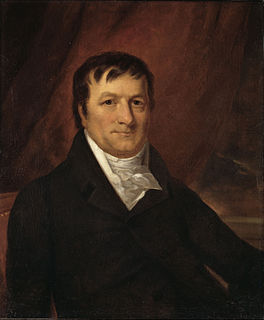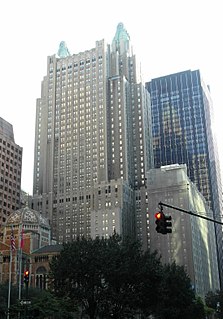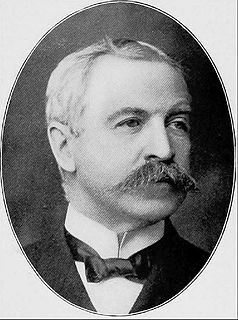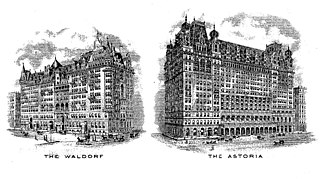Anthroposophy is a philosophy founded in the early 20th century by the esotericist Rudolf Steiner that postulates the existence of an objective, intellectually comprehensible spiritual world, accessible to human experience. Followers of anthroposophy aim to engage in spiritual discovery through a mode of thought independent of sensory experience. They also aim to present their ideas in a manner verifiable by rational discourse and in studying the spiritual world seek comparable precision and clarity to that obtained by scientists investigating the physical world.

John Jacob Astor was a German-American businessman, merchant, real estate mogul, and investor who made his fortune mainly in a fur trade monopoly, by smuggling opium into China, and by investing in real estate in or around New York City. He is known for being the first multi-millionaire businessman of the United States.
Astoria is a placename, ultimately named for businessman John Jacob Astor (1763–1848), in the 1840s the wealthiest person in the United States and, as a hotel name, his great-grandson William Waldorf Astor (1848–1919).

The Waldorf Astoria New York is a luxury hotel in Midtown Manhattan in New York City. The structure, at 301 Park Avenue between 49th and 50th Streets, is a 47-story 625 ft (191 m) Art Deco landmark designed by architects Schultze and Weaver, which was completed in 1931. The building was the world's tallest hotel from 1931 until 1963, when it was surpassed by Moscow's Hotel Ukraina by 23 feet (7.0 m). An icon of glamour and luxury, the current Waldorf Astoria is one of the world's most prestigious and best-known hotels. Waldorf Astoria Hotels & Resorts is a division of Hilton Hotels, and a portfolio of high-end properties around the world now operate under the name, including in New York City. Both the exterior and the interior of the Waldorf Astoria are designated by the New York City Landmarks Preservation Commission as official landmarks.
The Astor family achieved prominence in business, society, and politics in the United States and the United Kingdom during the 19th and 20th centuries. With ancestral roots in the Italian Alps, the Astors settled in Germany, first appearing in North America in the 18th century with John Jacob Astor, one of the wealthiest people in history.

William Waldorf "Willy" Astor, 1st Viscount Astor was an American-British attorney, politician, businessman, and philanthropist. Astor was a scion of the very wealthy Astor family of New York City. He moved to Britain in 1891, became a British subject in 1899, and was made a peer as Baron Astor in 1916 and Viscount Astor in 1917 for his contributions to war charities.
Waldorf can have the following meanings:
Eurythmy is an expressive movement art originated by Rudolf Steiner in conjunction with Marie von Sivers in the early 20th century. Primarily a performance art, it is also used in education, especially in Waldorf schools, and – as part of anthroposophic medicine – for claimed therapeutic purposes.
Waldorf Astoria New York is a historic Manhattan hotel built in 1931.
Emil Molt was a German industrialist, social reformer and anthroposophist. He was the director of the Waldorf-Astoria-Zigarettenfabrik, and with Rudolf Steiner co-founded the first Waldorf school. Hence, Waldorf education was named after the company.
This article on the History of Waldorf schools includes descriptions of the schools' historical foundations, geographical distribution and internal governance structures.

Waldorf education, also known as Steiner education, is based on the educational philosophy of Rudolf Steiner, the founder of anthroposophy. Its pedagogy strives to develop pupils' intellectual, artistic, and practical skills in an integrated and holistic manner. The cultivation of pupils' imagination and creativity in ways that serve their developmental needs is a strong focus.
Eugen Kolisko was an Austrian-German physician and educator who was born in Vienna. He studied medicine at the University of Vienna, and in 1917 became a lecturer of medical chemistry. He was the son of pathologist Alexander Kolisko (1857-1918).

Louis Sherry was an American restaurateur, caterer, confectioner and hotelier during the Gilded Age and early 20th century. His name is typically associated with an upscale brand of candy and ice cream, and also the Sherry-Netherland Hotel in New York City.
The Friends of Waldorf Education, referred to as the “Friends” below, is a charity association founded in 1971 registered in Stuttgart, Germany. The association fosters initiatives all over the world for a free education and organisations that work on the basis of Waldorf education.
Ernst Weissert, born 20 July 1905 in Mannheim Germany and died 2 January 1981 in Stuttgart was a teacher, general secretary of the Anthroposophical Society in Germany and co-founder and director of the Bund der Freien Waldorfschulen, the Hague Circle and the Friends of Waldorf Education.
Else Klink was director of the Eurythmeum Stuttgart, the first training centre for Eurythmy founded by Marie Steiner in 1923, from 1935 until 1991. In 1945 she established the Eurythmeum Stage Group, which she also led until 1991. Her work contributed centrally to establishing Eurythmy as a performing art within the culture of Europe and internationally.

The Waldorf–Astoria originated as two hotels, built side by side by feuding relatives on Fifth Avenue in Manhattan, New York City. Built in 1893 and expanded in 1897, the Waldorf–Astoria was razed in 1929 to make way for construction of the Empire State Building. Its successor, the current Waldorf Astoria New York, was built on Park Avenue in 1931.

Waldorf-Astoria Cigar Company was the cigar company of the original Waldorf–Astoria Hotel in Manhattan, New York City. Its headquarters were located in the building's basement on the Fifth Avenue. The humidors were situated in a lower basement, as was the company's Cuban cigar stock. Its value was estimated between US$300,000-$400,000. Waldorf-Astoria Cigar Company and its contemporaries, such A. Schulte and Robert E. Lane, grew out of the local competition caused by the large volume of sales and uniform business methods of the United Cigar Stores. Life Magazine advertised that the first shipment of the LA SAVOIE brand of Havana cigars ever made to the US was made to the Waldorf-Astoria Cigar Company.
Johannes Tautz (30 September 1914 in Koblenz am Rhein to 13 March 2008 in Dortmund, was a historian, religious scholar, Anthroposophist, author and Waldorf teacher. He concerned himself with a better understanding of National Socialism and with questions of education in the twentieth century.






